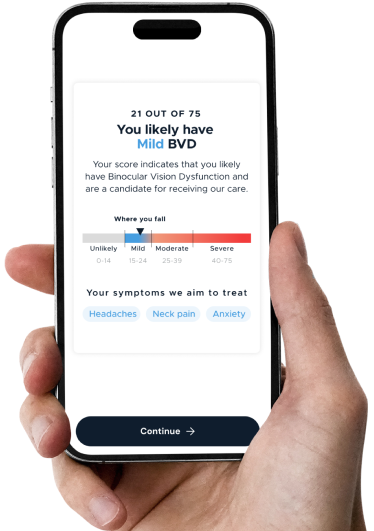Unlike routine eye exams that assess vision clarity and prescriptions, a NeuroVisual Evaluation identifies subtle eye misalignments that cause Binocular Vision Dysfunction (BVD). This specialized exam takes 1–2 hours and can lead to treatment with custom prism lenses that relieve symptoms like dizziness, headaches, and eye strain.
NeuroVisual Evaluation vs. Routine Eye Exams: Key Differences
Why a NeuroVisual Examination Is Crucial
In most cases, during a standard eye exam, the tests and testing performed are just not sensitive enough to reveal the very small amounts of vision misalignment associated with Binocular Vision Dysfunction (BVD). In addition, because BVD symptoms can also be indicators of other medical conditions, patients have been known to be seen by other types of doctors and been diagnosed as having vertigo, sinus headache or migraine disorder when they really have BVD.
If left untreated, patients with BVD can experience multiple symptoms that range from uncomfortable to debilitating. Along with headaches and dizziness, these include neck pain and anxiety, gait instability, motion sickness, nausea, sensitivity to light, and reading and learning challenges.

How BVD Symptoms are Triggered
People who suffer from Binocular Vision Dysfunction have a very small amount of vision misalignment. As the body works to correct this misalignment, the eye muscles become overused and strained, causing the symptoms of BVD to manifest. While the type and severity of symptoms and their rate of occurrence varies from patient to patient, they do tend to have common triggers. These include sudden movements such as driving fast on curvy roads, riding in the passenger seat of a vehicle, rising too quickly or being in a crowded room. If you’ve had regular eye exams but are still experiencing one or more of the previously mentioned symptoms, a free, scientifically validated BVD assessment can tell you if this is the answer. If so, a NeuroVisual Evaluation can help a NeuroVisual Medicine specialist prescribe you aligning lenses.
Treatment With Aligning Lenses
During this evaluation, a NeuroVisual specialist will check for the subtle eye misalignments that just aren’t identified during a routine eye exam, spending one to two hours conducting a comprehensive examination to ensure a proper diagnosis. If BVD is found, the NeuroVisual specialist will then prescribe customized aligning prismatic lenses, which will begin correcting the misalignment to quickly reduce or even eliminate symptoms.
If BVD symptoms are disrupting your life, relief may be in sight. Start by taking the BVDQ™ Assessment to learn if BVD is causing your symptoms.

